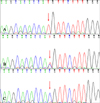Dear Editor:
Hypohidrotic ectodermal dysplasia (HED) is characterized by the abnormal development of the eccrine sweat glands, hair, and teeth. The X-linked form of the disease, caused by mutations in the ED1 gene, represents the majority of HED cases. Most subjects with X-linked HED harbor mutations in the ED1 gene, which has a detection rate of 63% to 95%1. X-linked HED mainly occurs in men, whereas females are carriers. The affected organs are of ectodermal origin, but the nervous system is usually unaffected. Atopic dermatitis and bronchial asthma are frequent complications2.
Here we in a Chinese family with X-linked HED show one mutation. The family belonged to the Han population of China and comprised two patients and their parents (Fig. 1). Two affected males fulfilled the diagnostic criteria of this disorder. The proband was a 5-year-old boy. He had fine curly sparse hair, abnormal teeth, and dryness of several skin areas, and had a recurrent fever of 38℃ due to the absence of sweating since birth, which was more frequent and obvious in summer and during moving. He also had a characteristic facial appearance of X-linked HED, including frontal bossing, absent or scarce eyebrows, a saddle nose, periorbital wrinkling and hyperpigmentation, and thickened, everted lips (Fig. 1)3. In addition, his mother's brother had similar symptoms and clinical onset. Both their parents were healthy.
After obtaining informed consent, blood samples were collected from members of the family and 100 unrelated population-matched controls. Genomic DNA was extracted from the peripheral blood lymphocytes by standard procedures using Flexi Gene DNA kits (Qiagen, Shanghai, China), and was stored at -80℃ before the test. Eight coding exons and flanking sequences of the ED1 gene were amplified by polymerase chain reaction (PCR) using primers reported previously4. After the amplification, the PCR products were analyzed by agarose gel electrophoresis, and purified with a QIAquick PCR purification kit (Qiagen). Finally, they were sequenced using an ABI-PRISM 3730XL automated DNA sequencer with forward/reverse universal and internal primers.
The ED1 gene encodes a protein, ectodysplasin-A, recognized to be a member of the tumor necrosis factor (TNF) superfamily of ligands, which may be associated with its function. Ectodysplasin-A is involved in the regulation of ectodermal morphogenesis. To date, above 206 mutations in the ED1 gene have been included in the homo-sapiens gene bank, including missense mutations, nonsense mutations, splice junction mutations, small deletion/insertion mutations and large deletion or molecular transposition. Direct DNA sequence analysis showed one missense mutation (c.1133C>T) in exon 8 of the ED1 gene in the proband and his mother's brother. This mutation, located in the TNF homology domain, resulted in a change of Threonine (ACG) residue at codon 378 to Methionine (ATG) (p.T378M). At the same nucleotide position, the proband's mother was heterozygote with wild and mutant types. And this mutation was not found in the proband's father or 100 normal controls (Fig. 2). This result suggested that the c.1133C>T (p.T378M) mutation of the ED1 gene may be the pathologic cause of this X-linked HED Chinese family with.
In summary, we demonstrated one missense mutation p.T378M in the ED1 gene responsible for X-linked HED in the Chinese Han population. We hope this result will be useful for genetic counseling, carrier detection and prenatal diagnosis in X-linked HED families.
Figures and Tables
ACKNOWLEDGMENT
We would like to thank the patients for participating in the study. This work was supported by MOE of China (IRT-1046).
References
1. Zhang J, Han D, Song S, Wang Y, Zhao H, Pan S, et al. Correlation between the phenotypes and genotypes of X-linked hypohidrotic ectodermal dysplasia and non-syndromic hypodontia caused by ectodysplasin-A mutations. Eur J Med Genet. 2011; 54:e377–e382.

2. Kere J, Srivastava AK, Montonen O, Zonana J, Thomas N, Ferguson B, et al. X-linked anhidrotic (hypohidrotic) ectodermal dysplasia is caused by mutation in a novel transmembrane protein. Nat Genet. 1996; 13:409–416.





 PDF
PDF ePub
ePub Citation
Citation Print
Print




 XML Download
XML Download